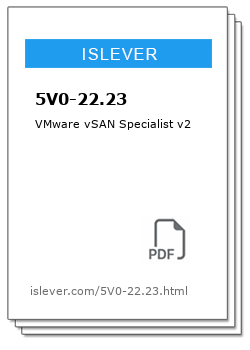Description

Exam 5V0-22.23: VMware vSAN Specialist v2
|
Unlock the Shortcut to Quick Exam Success with 5V0-22.23 Mock Tests! Tried and tested by countless students, our 5V0-22.23 Tests are your express ticket to acing the 5V0-22.23 exam. Packed with the latest exam questions and answers, these study materials are designed to save you precious time and energy. Say goodbye to the stress of exam preparation and hello to your coveted certification. Our study materials come in PDF format, featuring a comprehensive collection of exam questions. VMware vSAN Specialist v2. Master these questions, and you're well on your way to passing the exam with flying colors. |
DEMO
Question #1
A vSAN administrator has a group of requirements from the application team, which mandates spreading the components across storage devices as much as possible.
What should the vSAN Administrator consider to achieve such a requirement for building a new vSAN cluster? (Choose two.)
- A. Configure disk striping in OSA
- B. Configure disk striping in ESA
- C. Enable Force Provisioning in OSA
- D. Enable deduplication for vSAN
- E. Create a dedicated Storage Pool in ESA
Answer: AB
Question #2
A site administrator wishes to implement HCI mesh between two clusters on vSAN that are located in geographically separate sites and which are administered within a single datacenter.
Which two requirements should the vSAN administrator consider to accomplish this goal? (Choose two.)
- A. Either Layer 2 or Layer 3 communications can be used
- B. A leaf spine topology is required for core redundancy and reduced latency
- C. NIC teaming must be implemented for the vSAN network vmkernel port
- D. The configuration must meet the same latency and bandwidth requirement as local vSAN
- E. Encryption must be disabled prior to configuring HCI mesh
Answer: AD
Question #3
An administrator has 24 physical servers that need to be configured with vSAN. The administrator needs to ensure that a single rack failure is not going to affect the data availability. The number of racks used should be minimized.
What has to be done and configured to achieve this goal?
- A. Distribute servers across at least two different racks and configure two fault domains
- B. Configure disk groups with a minimum of four capacity disks in each server and distribute them across four racks
- C. Enable deduplication and compression
- D. Distribute servers across at least three different racks and configure three fault domains
Answer: D
Question #4
An administrator wants to assign a storage policy to a workload on a two-node vSAN OSA cluster consisting of three disk groups each with nested fault domains. The virtual machine must be protected against a disk or disk group failure.
Which two storage policies meet these requirements? (Choose two.)
- A. RAID-5/FTT 2
- B. RAID-1/FTT 3
- C. RAID-6/FTT 2
- D. RAID-5/FTT 1
- E. RAID-1/FTT 1
Answer: DE
Question #5 ... 82
VMware vSAN Specialist v2
Note: The 5V0-22.23 DEMO includes only a small portion of the actual product content. To access the complete material, please consider purchasing the product. Upon purchase, you'll receive a PDF file containing the entire content.
Additionally, our 5V0-22.23 brain dumps has been curated to exclude outdated, invalid, and erroneous information, ensuring a more effective learning experience for you.